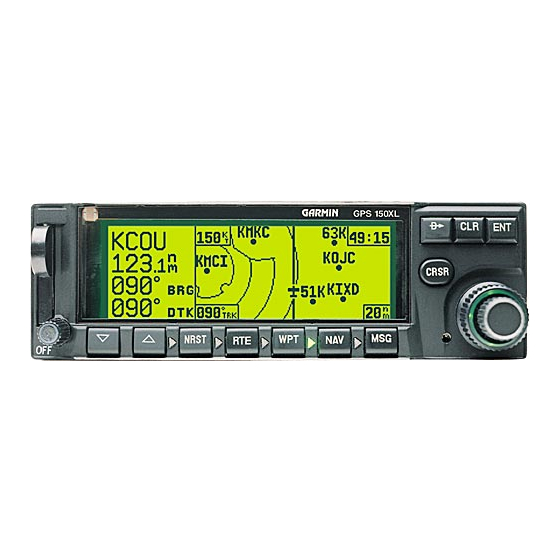- ページ 10
アビオニクス・ディスプレイ Garmin GNC 250のPDF 整備・修理マニュアルをオンラインで閲覧またはダウンロードできます。Garmin GNC 250 20 ページ。 Garmin gnc 250: quick reference
Garmin GNC 250 にも: パイロット・クイック・リファレンス・マニュアル (25 ページ), インストレーション・マニュアル (44 ページ)

Figure 4. GPS Receiver Block Diagram
1.2.4 Interface Board and Data Cards
The Interface Board provides two-way data transfer capability between the CPU board and a data card
NavData® cards allow for data transfer to the CPU board only. User data cards, with 128 kilobytes of
flash memory data storage, may be used to save user data/settings from the GNC 250/300 or restore
that information to the GNC 250/300. Address and data lines from the CPU board route through the
Interface Board's output buffers to the data card. A plastic race secures the Interface Board at the
front of the unit and serves to guide the data card onto the 40-pin connector.
NOTE: When servicing the GNC 250/300, user-defined waypoints, routes, settings, etc., may be
saved on a user data card (010-10032-03) first. In the event these data are lost, they may then be
restored from the user data card before the unit is returned to serve. Refer to Appendix A of the
GNC 250/300 Pilot's Guide for additional information on user data card operation.
1.2.5 VHF Communications Transceiver
The VHF communications transceiver consists of the comm receiver board assembly and the
transmitter board and casting assembly. The VHF receiver is a single conversion super-heterodyne
AM receiver operating from 118.000 to 136.975 MHz with 25 kHz channel spacing for a combined
total of 760 channels. Received signals are routed from the antenna via the antenna switch to the RF
pre-selector where they are filtered and amplified. The received signal is down-converted to a 21.4
MHz IF via the mixer.
The mixer local oscillator signal (LO) is generated by the synthesizer which uses a crystal reference
oscillator to generate the LO frequency for each channel as well as the transmitter drive signal. After
down-conversion, the signal is filtered by a narrowband crystal IF filter, amplified by IF AGC
amplifiers, and the AM is detected by an envelope detector. The demodulated audio is filtered,
amplified and is held at a constant level by the receiver compressor circuits. The audio is routed
through a digital volume control IC and is transformed coupled out of the unit via connector J2. The
serial data which tunes the synthesizer as well as controls the digital volume chip is generated by the
CPU board.
7
